We often say the word “pixel” and are used to the fact that there should be a lot of them. But it was not always so. It all started with screens, in which there was no need to talk about resolution at all. The picture was shown in very poor quality, but people still believed in what was happening and were shocked that this was possible at all. Now we are difficult to deceive and we increasingly take the image for granted. There is nothing wrong with that, but this quick addiction proves once again how rapidly technology is developing. Today I propose to remember how pixels developed, and what interesting facts were on the way of this development. Let's take a look at this elementary particle of our everyday life.

Screens have become an integral part of our lives.
Considering how much content we consume and how dependent on images on the screen, be it work or play, it is very difficult to overestimate the small, seemingly insignificant pixel. However, you must admit that we pay attention to them only at the moment when we look at the screen and see a “broken” pixel. But it is these little squares that change their face several dozen times per second so that we can watch our favorite TV series or scroll through the Instagram feed.
Big screen
The whole story of what we are seeing now began a long time ago. It is difficult to name the first date, since the developments were carried out, and it would be more correct to talk about the date of the first public demonstration. She was shown the film “Arrival of a Train at La Ciotat Station” on December 28, 1885. This date is considered the birthday of cinema, but it can also be considered the starting point for all modern displays, including smartphone displays.
At that moment, people were shocked that this is possible, and that just a “wall” can show an image. There are even stories that people ran out of the hall when they saw a train on them. They were not embarrassed by the low quality of the picture and the fact that it was black and white. They just couldn't understand how a picture might not move in reality.
It turns out that the first screen was exactly “big” and only later screens for home use began to appear. The first home TVs were released, as you might guess, only after their invention. This happened a few decades after the first film screening, and the authors of the invention were Konstantin Persky (the first to use the term 'television'), Boris Rosing (who received the first patent for the electronic television technologies used so far) and his student Vladimir Zvorykin, who is considered one of the the creators of modern television.
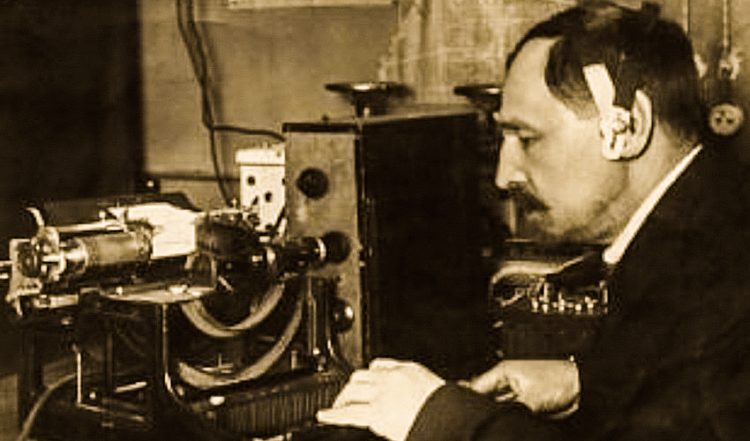
Boris Rosing at work.
The first transmission of a moving image to a television receiver in history took place on July 26, 1928 in Tashkent. And the first serial TVs were sold by the American company Western Television in 1929. The device was named Visionette. True, due to the high price of $ 100 (about $ 1,500 in our time) and the complexity of the design, it was not widely used.
The complexity of the design was that in order to receive a signal, the TV was connected to a radio receiver, being, in fact, a prefix for it, and the second radio receiver caught the sound, being tuned to a different frequency. With all this, the screen was no larger than a postage stamp, and even the lenses made it impossible to see the scene or people's faces in detail, except in a close-up.
The first mass TV in the USSR, on which it was already possible to more or less fully watch broadcasts, appeared in 1949 and was produced until 1961. It was called KVN-49 and was named after the first letters of its creators (Kenigson, Varshavsky, Nikolaevsky) and the year of issue.
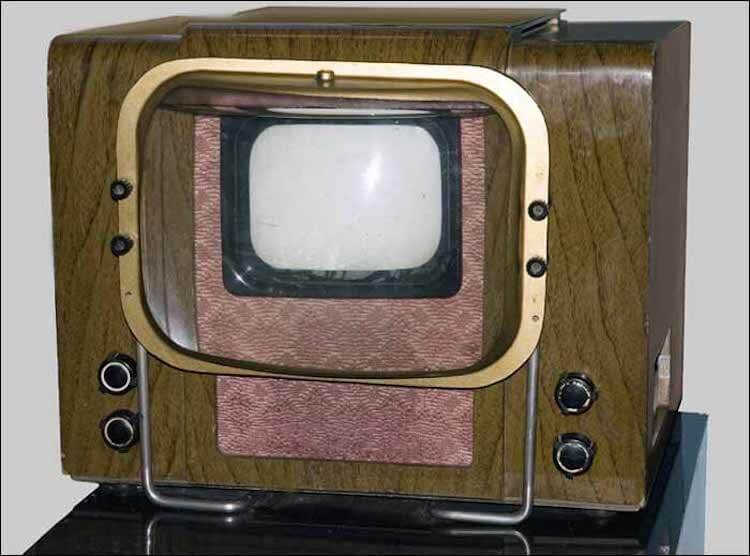
The famous KVN-49.
He also needed a lens to work. A large water tank served as it. At first, distilled water was poured into it, and later they realized that glycerin could be poured and this would have a positive effect on the image quality due to its better optical properties. Then there were already massive broadcasts and on a screen measuring 10 by 14 centimeters, after enlarging it with that very lens, even a collective viewing could be arranged. Although, many people still used it mainly in the background to play sound.
In those days, it was somehow not necessary to talk about the resolution of the picture, since the picture was formed due to a cathode-ray tube, which bombarded the phosphor coating of the inner side of the glass with electrons. It was because of this coating that the glass was not transparent even when turned off. But the glow of this layer gave out the picture.
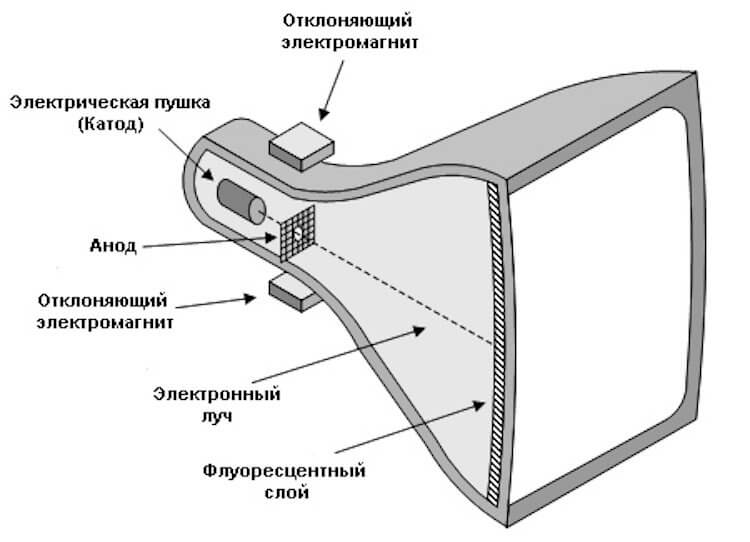
CRT TV design.
Televisions of the time were forced to have a convex screen so that electrons travel an equal path from the tube to any point on the screen. The large size was due to the fact that the electrons had to be accelerated before reaching the phosphor. The pipe itself did not hit in one line, but “ran along the lines” with great frequency. This is how the odd and then even lines were drawn first. This scan was called interlaced. Sometimes she can be found now.
What are TVs
Time passed, technologies developed and people wanted more. For obvious reasons, televisions and cathode ray tube computer monitors that appeared a little later could not provide an increase in size. It was almost impossible to make a large glass flask. Not only did it weigh an immense amount, it was also difficult to produce if you continued to increase its size.
As a result, projection TVs first appeared, which were relatively thin, but allowed to make large screens. One of the most famous models was the British system 'Scophony' (English Scophony), which gave an image of 2.8 × 3.7 meters.

This is what a projection TV looks like.
The picture quality of such screens was, to put it mildly, so-so. The image was projected onto a semitransparent screen, and this led to insufficient image brightness, distortion and loss of quality when the image was “stretched” to such a large size, because the image quality was still low. Some examples of such screens were produced even at the beginning of this millennium, but were used mainly for presentations or for installation in public places.
Another type of screens were gas-discharge screens, or as they were also called plasma, or “plasma” among the common people. The operation of the screen was based on the glow of a phosphor on the inner side of the screen under the influence of ultraviolet rays arising from an electric discharge in an ionized gas, in other words, in a plasma.
The technology was patented by its creators Dr. Donald Bitzer, H. Gene Slottow and Robert Willson in 1964. Such screens were quite expensive, relatively poor in image quality, and after LCD technology became cheaper, they simply could not stand the competition. They have been massively produced since the early 90s of the last century. In 2014, production almost ceased.
First LCD screen
Liquid crystal displays LCD, which began to appear about 30 years ago, became a real hit for many years to come. The very first screens made with this technology were not related to televisions. They could display no more than 5 colors and were used in various devices. This application continues now.
The liquid crystals themselves were discovered back in 1888 by the Austrian botanist F. Rainitzer. Although the first screen with such technology appeared only in 1968, and the first mass-produced device with an LCD screen was presented by Sharp. This device was a calculator. From that moment on, such screens began to be used in watches and other devices. At that time, the technology was unsuitable for use on large screens.
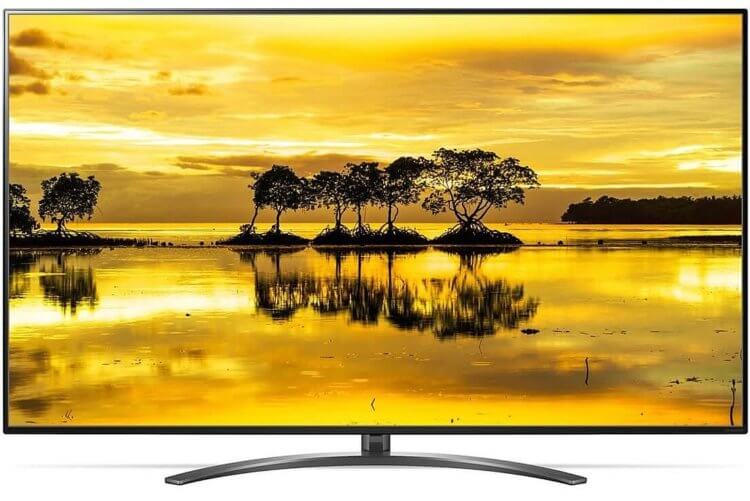
LCD screens have become simply irreplaceable for us.
The first color LCD is also Sharp's pen. It was released in 1987 and has a 3-inch diagonal. A year later, the same company released a 14-inch TFT LCD.
Thus, the production of displays came to an image that was broken down into its component parts in the form of small cells – pixels. Before that, there was no need to talk about pixels either, since a luminous phosphor was responsible for the image, which did not have such a division.
After the appearance of LCD displays for some time, they, without interfering with each other, shared a niche with plasma panels. At first, there was a clear division by size. LCDs couldn't be big, and plasma screens couldn't be small. Later LCD they began to enter the territory of “plasma”, and the reduction in the cost of technology finally killed the latter.
How it works LCD
At the heart of LCD screens, whether it's a TV, smartphone, monitor, or something else, is a seemingly simple sandwich. It consists of the layer of liquid crystals itself, which can change their optical properties under the influence of an electric current, two transparent electrodes, as well as horizontal and vertical filters. There is also a color filter that allows you to adjust the features of the rest of the design and bring the colors of the image to normal, which will be more natural or just branded.
Above, the design of the image source is described, but the display module assembly has several more elements. For example, wires for connecting to a source, fasteners, backlighting, if any, and a case (more plastic with a metal frame).
The higher the resolution of the matrix, the more complex it is, consumes more power and requires more processing power of the device. That is why some smartphones have a resolution adjustment system. It is reduced to save energy. There is no such need for monitors and TVs.
An important characteristic is the pixel response (the time it takes for it to change its color). If it is not very large, for example, more than 5ms, such a screen is suitable for almost everything except high-speed games. The resolution of the matrix is also important, but you should not chase it and blindly believe that the more the better.
For example, for a smartphone, a resolution of 1080 pixels on the narrow side is sufficient. With this resolution, the eye no longer clings to individual pixels and can perceive the image as real. For a TV, this resolution is sufficient with a small diagonal. If we talk about a panel with a diagonal of 60 inches or more, it is better to have 4K resolution already. There are also 8K panels, but their time has not come yet. Moreover, there are technologies that can prevent their appearance, but more about them below.
Why display resolution doesn't matter
Many users are chasing high definition pictures and maximum frame rates, but there is also an alternative opinion. According to him, you should not unnecessarily improve the picture. The authors of this opinion are partly right, and here's why.
As a rule, filmmakers think so. They are convinced that there is no need to deviate from the classic 24 frames per second format. Many even strongly criticized the creators of The Hobbit, who shot the film at 50 frames per second. According to professionals, the picture should be a little blurry. This allows her to create a certain mood in a person and a feeling of immersion in a fictional world.

This film was shot at 50 fps and received a wave of criticism.
Of course, viewing nature, sports or technology in high definition is very pleasant, but watching a movie in 4K and seeing the flaws of make-up artists and skin imperfections of the actors is still fun. Perhaps that is why filmmakers are against increasing the clarity of the picture. They just don't want anyone to see their flaws.
New type of display. Interpolation display
Interpolation displays were created not so long ago and have not yet proven their serious prospects, but many companies have taken the principles laid down in it as the basis for their future developments. This is not a full-fledged step forward and not ready-made TVs in one case, but rather a small look back, but with prospects for the future.
The screen, on which the image from the projector falls, is not reflected as from a normal screen, but is re-polarized. At the same time, it is based on a phosphor layer, which allows you to make the image clearer. Essentially, an image is obtained with infinite clarity due to the lack of pixels.
The screen itself does not have a classic white, but a black structure. This makes it possible to reproduce pure blacks, which is the weak point of normal projector playback.

Projectors have both pros and cons in front of screens.
The technology may never take off, but if everything works out, it will turn out that in the field of home cinema we will go back in time and move away from the pixels in the final image that have accompanied us for the last couple of decades. Of course, this does not apply to mobile electronics, which simply cannot work with such technology. The use of OLED displays is perfect here. Of course, after they have lost their shortcomings.
How OLED works – screen
Such a disadvantage is flicker, especially at low brightness. The brain does not interpret such flickering and we think that we do not see it, but it hurts our eyes very much. IPS displays still perform better in this regard, although they cannot provide such a deep black color.
The technology is based on organic light-emitting diodes (abbr. OLED). It is a semiconductor device made from organic compounds that effectively emit light when an electric current passes through them.
Due to its peculiarities, such a screen can work without external illumination. The brightness of the image is achieved by the glow of each specific pixel. This allows you not to “overexpose” dark areas, making them gray. Thanks to these features, the screens provide an almost infinite contrast ratio of 2,000,000: 1 or more.
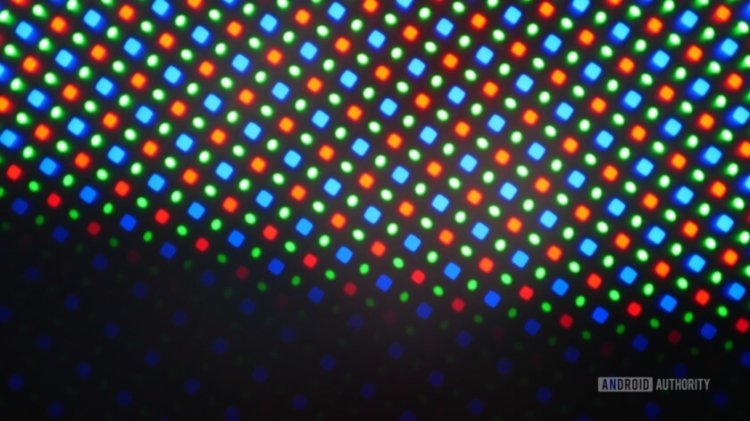
OLED is good, but not without flaws.
In this case, the brightness is usually limited to 1000 cd / m², although much higher values are possible, but they are not needed by a common user. And the resource with increasing brightness OLED – the panel is greatly reduced.
It is also worth adding that those who believe OLED – screens are more economical than IPS, are only partially right. In fact, they consume more power, even taking into account the display of dark areas, the pixels in which are inactive. It is not the IPS technology itself that loses in efficiency, but its indispensable companions – the backlight and the controller. As a result, especially in a dark image, OLED comes out strongly. But on the bright one he loses.
Which screen to choose
As you can see, the evolution of screens has come a long way, which is difficult to fit into the framework of one article. But even in these several thousand signs, development trends can be traced. While we are talking about increasing clarity and reducing the size, but some technologies tend to go back. And we can also conclude that everything went from the cinema. It was he who gave us the understanding that we really need to display dynamic information. Although, if not for him, the “trigger” would still be, just in something else.
Everyone chooses a screen for themselves, but now there are three main technologies that can be considered modern for now – organic LEDs, liquid crystals and various projection methods. Each area has its own technology, but it's so nice that we have choice and competition, from which only we, ordinary consumers, benefit in the end.
